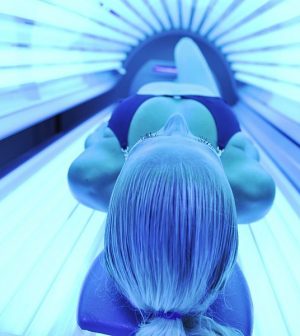- Navigating Your Midlife Crisis: Embracing New Possibilities
- City Raccoons Showing Signs of Domestication
- Mapping the Exposome: Science Broadens Focus to Environmental Disease Triggers
- One Week Less on Social Media Linked to Better Mental Health
- Your Brain Changes in Stages as You Age, Study Finds
- Some Suicide Victims Show No Typical Warning Signs, Study Finds
- ByHeart Formula Faces Lawsuits After Babies Sickened With Botulism
- Switch to Vegan Diet Could Cut Your Greenhouse Gas Emissions in Half
- Regular Bedtime Does Wonders for Blood Pressure
- Dining Alone Could Mean Worse Nutrition for Seniors
Teen Tanning Bed Ban Would Prevent Thousands of U.S. Melanoma Cases

A U.S.-wide ban on teen use of tanning beds would prevent thousands of cases of skin cancer and save millions in health care costs, researchers say.
Indoor tanning has been linked to an increased risk of melanoma — the deadliest type of skin cancer — and the highest risk is among people who start using tanning beds at a young age. Despite that danger, many U.S. teens do.
While banning the beds can save lives, only a few countries have done so.
“A ban on tanning bed use in minors is not universal in Canada and the U.S.,” said lead author Dr. Antoine Eskander of the University of Toronto. “In Brazil and Australia there is a total ban not just in minors, while in Austria, Belgium, France, Germany, Portugal, Spain and the United Kingdom, national bans exist for those under the age of 18.”
To determine the benefits and costs of a ban in the United States, researchers analyzed the potential impact if 14- to 17-year-olds were banned from using tanning beds.
They estimated that full adherence to a ban would prevent 15,101 cases of melanoma and 3,299 repeat cases among 17.1 million American teens. That would save an estimated $61 per teen in direct and indirect health care costs.
After including the costs of implementing a ban and the economic losses to the tanning bed industry, researchers projected that a ban would still save $205.4 million over the 17.1 million teens’ lifetimes.
The findings were published April 12 in the journal Cancer.
“This work demonstrates the societal implications of a ban in North America and points to the value of this policy, which should be considered by state, provincial and national/federal governments,” said co-senior author Dr. David Goldstein.
Eskander and Goldstein both spoke in a journal news release and practice in the Department of Otolaryngology–Head and Neck Surgery at the University of Toronto.
More information
The U.S. Food and Drug Administration has more on the risks of indoor tanning.
SOURCE: Cancer, news release, April 12, 2021
Source: HealthDay
Copyright © 2025 HealthDay. All rights reserved.










